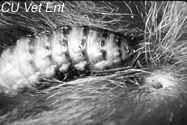|
Cattle Grub Treatments

Figure 1. Cattle grub and exit hole in hide
Photo: Cornell University Veterinary Entomology
DR. LEE TOWNSEND
LEXINGTON, KY.
Cattle grubs damage muscle tissue along the back line of cattle and cut holes in the hide to breathe (Figure 1). The results of their handiwork generally do not appear until February, but now is the time to apply the preventive treatment that will keep them under control.
Heel flies, the adult stage of cattle grubs, glue their eggs to hairs of the legs and lower body region of pastured cattle during summer. Newly hatched larvae enter the skin and begin their long migration to the back.
Treating with Insecticides
Systemic insecticides can control cattle grubs as they move through the animal’s body. To avoid complications, cattle grub treatment must be made after egg laying has ended for summer and before migrating larvae reach the esophagus or spinal cord. Treatments applied too late may cause toxic reactions.
The treatment window varies depending on where cattle spent the summer. In the latitude of Kentucky, cattle should be treated for grubs between July 31 and October 15. During this period, the fly larvae are very small and vulnerable to the insecticide.
Use care when treating for cattle grubs. Accurate animal weights allow economical and effective treatment. Over-dosing wastes money and may cause animal stress; under-dosing may result in unsatisfactory control. ∆
DR. LEE TOWNSEND: Extension Entomologist, University of Kentucky
|
|